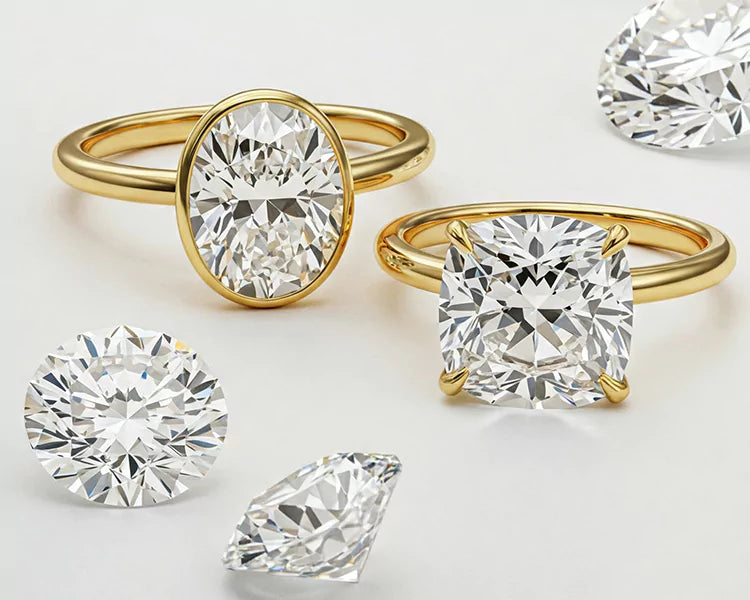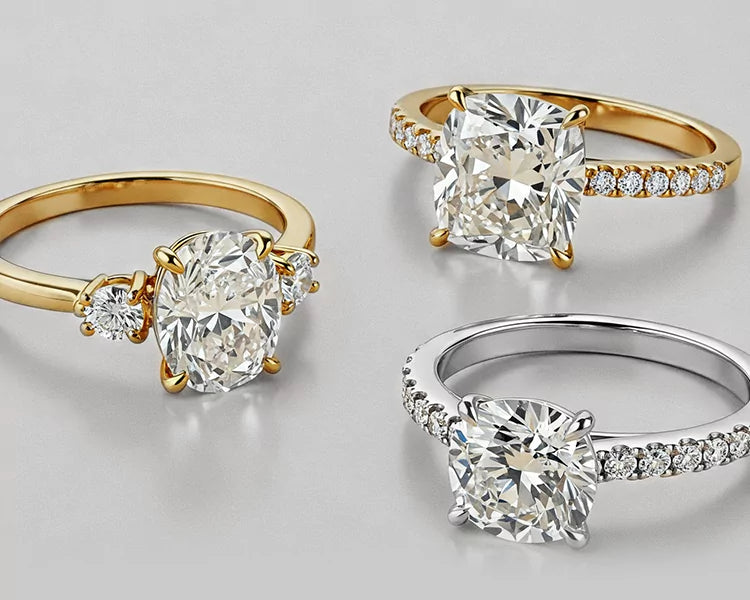Diamond clarity is all about how many internal "inclusions" or external "blemishes" a diamond does not have. Picture inclusions as birthmarks that formed while the diamond was growing way down under the ground or in a science lab!
These little flaws might change the way light travels through the diamond thus affecting its sparkle and shine. But catch this: lots of these inclusions are super tiny and you can't spot them without using a magnifying tool. So even though clarity's important, it doesn't always make or break the deal.
Diamond Clarity Chart: To grasp the different levels
GIA, that's the Gemological Institute of America, breaks down their official clarity grades for diamonds from super rare and pricey to those with more stuff inside them that makes them more wallet-friendly:
1. Flawless (FL)
What it means:You won't see any specks or scratches when you look closely, like with a 10x zoom.
How common:Super uncommon, less than 1% of all the sparkly stones.
Cost:Expect to pay top dollar, these babies don't come cheap.
What you see:It's perfect both to the naked eye and with a magnifying glass.
Definition:Zero inclusions inside yet might sport tiny specks on the surface.
Rarity:Super uncommon.
Price:Priced just below FL.
Visibility:Looks spotless to the eye and almost flawless under zoom.
2. Internally Flawless (IF)
Definition:No internal inclusions, only tiny surface blemishes.
Rarity:Also very rare, just a notch below FL.
Price:Slightly less than FL, but still among the most expensive.
Visibility:Totally clean to the eye and nearly flawless under magnification.
Ideal For:Perfectionists who want near-FL quality without the FL price tag.
3. Very Very Included (VVS1 VVS2)
Definition:The inclusions are so microscopic that even pros in gemology have a tough time seeing them.
Rarity:Still on the scarce side.
Price:On the pricey side but you'll save a bit compared to FL or IF.
Visibility:To the bare eye, it's pretty much impeccable.
4. Very Included (VS1 VS2)
Definition:These have small inclusions invisible without magnification.
Popularity:suggested by experts.
Price:Good balance of transparency and expense.
Visibility:Often looks clean to the bare eye.
Diamond Clarity's Big Deal

Why fuss over how clear a diamond is? Well the more see-through it is the better it plays with light giving you that bling factor. But let's clear something up real quick: A perfect gem isn't a must for an awesome ring. Truth is most folks can't even spot the difference between a VS1 and an FL just by looking.
The real challenge lies in weighing up the 4Cs—clarity, cut, carat, and color. Often, a cut VS2 or perhaps an SI1 diamond will outshine a bad cut IF diamond.
So rather than go after perfection, ponder over this: 'Can I spot the defect without a loupe or a magnifying tool?' If the answer's no, you might pocket hundreds (or thousands) which you can shell out on a bigger gem or a more extravagant ring setting.
Classifying Diamond Imperfections: Inclusions vs. Blemishes
Getting to grips with different flaws is crafty for a wiser buy. Here's the lowdown:
Internal Inclusions
Feathers:They're like small inside breaks.
Clouds:These are bunches of tiny dots that make the diamond kind of foggy.
Crystals or Minerals:If you look close, you'll see these tiny bits of crystal or minerals stuck inside.
Needles:Think real long skinny things that got trapped.
Knots:These are the crystals that poke through to the top.
Not-so-perfect on the Outside
Polish Lines:These are fine streaks left from when the diamond got its shine.
Scratches:Just some marks hanging out on the surface.
Nicks:Little chip-offs right around the edges.
Pits:Teeny dents on the outside.
Naturals:Parts of the original rough diamond left untouched.
Checking Out Clarity: What Matters the Most
The 6 Major Points to Look At
Think gemstone detective. Here's what you need to peep at:
Size of the stuff that shouldn't be there.
The number of these little invaders.
Their spot in the diamond.
Whether you can see them with naked eyes.
The diamond's color—like, do these things stand out or what?
How all of it takes a toll on the diamond's sparkle.

When gemologists grade diamond clarity, they look at different details:
Size :Bigger imperfections mean a lower clarity grade.
Number :More imperfections lower the clarity.
Position :Flaws right in the middle (table) stick out more.
Nature :Certain types of imperfections mess with performance a lot.
Relief :Inclusions with sharp contrast catch your eye easier.
Diamond Shape:The way a diamond is cut, like brilliant styles, helps hide flaws better than other styles such as step cuts.

Cool Fact:Round, cushion, and princess shapes are pretty chill about hiding blemishes. But, if you're eyeing an emerald or Asscher cut, you'll need a higher clarity score.
Tricks to Pickin' the Perfect Diamond Clarity
Search for Diamonds That Look Perfect
Check if you can spot flaws with your own eyes rather than using a magnifying glass. A lot of the time, you can't see any blemishes on VS1, VS2, or a bunch of SI1 diamonds.
Think About How Big It Is and If You Can See Stuff
The larger the diamond the easier it is to spot any flaws. Go for at least VS1 quality if you're picking out a rock bigger than 1.5 carats.
Don't Skip Over the Diamond's Shape
How well the diamond is cut has a bigger influence on shine than how clear it is. A top-notch cut on an SI1 diamond might outshine a bad cut on a VVS1.
Choose Your Diamond's Crib
Those little metal claws on rings called prongs, can cover up the imperfections. Bezel and halo designs are also nifty for hiding any blemishes that are on the outskirts.
Ponder Diamond Cuts
Diamonds cut in a brilliant style, like the round, oval, or cushion, are champs at hiding those tiny imperfections. But those with step cuts, think emerald or Asscher just don't do the trick.
Insist on Official Certs
Only trust diamonds with clarity grades from the GIA or the AGS to be sure about how clear they are.
So, What Kinda Clarity Is Your Gem?
Depends on what you're after:
Total perfection seeker?FL or IF is your match.
Love that bling and a deal?VS1 or VS2 won't disappoint.
Dream of size but got a slim wallet?Eye-clean SI1 can save the day.
Wallet on a diet?SI2 or I1 could work if you've got smart hiding skills.
Talking Lab-Created Diamonds & Moissanite
You find lab-grown diamonds are the same as mined ones, but they don't hit your wallet as hard. A ton of VS and SI lab diamonds out there are super pretty and don't hurt the planet.
Then there's Moissanite, it's not expensive, shines like crazy, and has its very own clearness chart. , it looks even more spotless than diamonds and you'll save loads of cash.
Got worries about doing the right thing or saving dough? You should check out both of these.
Lab Grown Diamond Engagement Rings
Wrapping It Up: Clearness Ain't Everything

Okay here's what you need to know: Sure, clearness counts, but don't get hung up on it. How a diamond is cut and its shape can make it look way better than obsessing over if it's VVS1 or VS2.
Make sure not to get tripped up by all that sparkler jargon. Put your eyes in charge, stick to a clever budget, and team up with a trusty jewelry pro instead.
At the day's end, remember the diamond just needs to gleam, and with clarity done right, gleam it sure will.
Diamond Engagement RingsOn the hunt for that dream ring? We're here to make sure your sparkle comes without the headaches.
Happy Diamond Questioning!









